
Grantham and beyond!
(the Bristol perspective!)
The day arrived and I left Bristol at 0645. I picked Neil up outside of Falfield church, just off the M5 motorway at junction 14 and had a peaceful traffic-free (well, you know, no hold-ups) drive up to Grantham. In fact we made such good time we stopped off to see the Pugin-restored church at Wymeswold in Leicestershire and found it open as a nice lady was cleaning etc.
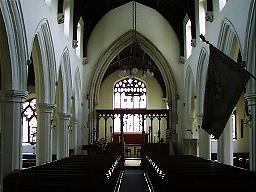
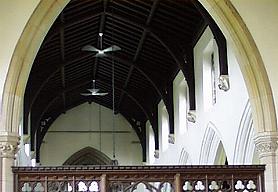
This church has three white ceiling fans in the roof of the nave, on 24/7 (using the modern speak). She said this is to combat woodworm etc but nearly everone now wished they were purchased in dark brown to match the roof! Usually this church is locked.
Got to Grantham at 1005, and spent the next 35 minutes struggling to get through huge traffic queues as the centre of town was closed off for a fair or something. The spire of the church drew us ever nearer as we circled the suburban streets. Given the number of people around, I was amazed to park in a side street within a few minute's walk of St Wulfrum's church.
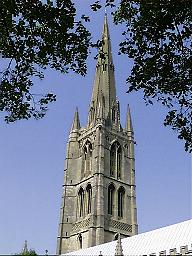
Sadly several people were unable to come at the last moment (OK - no names!) so we were four. Myself, Neil, Alan and Dr Digi. Alan and Dr Digi had met already as Neil and I hurried to the west door! Introductions done, we entered via the west portal and a half-built glazed doorcasing into the gloom of the church.
One of Englands larger parish churches, St Wulfrum is not a uniform building. Most of it dates from the Early English period of architecture of the later C13 and its Transitional phase into Decorated around c1300. Its side windows are like a pattern-book for Geometric tracery, and are certainly large. In my opinion the church looks its best from the west, where the lower stages of the tower recall Lincoln Cathedral west front. The flanking side windows are however of differing sizes, and the top stage of the tower itself with the twin two-light bell-openings under a single uniting hoodmould (creating a Y-tracery outline) is rather unsatisfactory given the elegance of the stage below. However the crocketed spire is breathtaking, and the whole is certainly among England's more notable steeples.
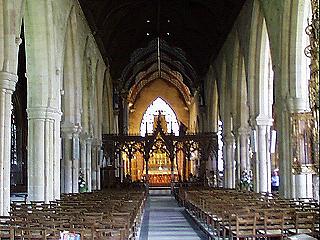
The interior is rather dark, and rather disappointing. I am sure that the church would have been more impressive - and lighter - if a clerestory had been added. The piers to the left and right are Transitional Norman, and the earliest part of the church, but the arches they carry are much later. The east window is Perpendicular and apart from the Victorian touches the latest part of the building along with the Chantry Chapel of St Kathryn, now used as a vestry. The Screen is by Sir G.G.Scott, much of the other fittings are C19 or early C20 too. The north porch is most impressive and now serves as a coffee shop, the south porch has a chained library in the room above, together with a small traceried window opening into the aisle, which enabled the priest to keep watch on the church treasures. In the south east corner is a crypt chapel, and this corner of the aisle has an east window of the more flamboyant "Curvilinear" style of the late Decorated period for which Lincolnshire is most famous.
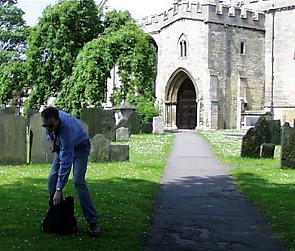
After this fairly lengthy inspection of what Simon Jenkins rates as a Five-Star church we were unanimous in saying a 5* spire but a 2-3* church. So as you can see we gathered our cameras etc (modelled by Dr Digi above) and headed for the cars and our next church.
All Saints, BARROWBY, Lincolnshire
We departed at 1145ish for Barrowby to see the transparent-stemmed font with the devil inside. We didn't. The vicar (several miles away) gave us two key-holders in the village to contact, but both were out. A third key-holder turned up without her key (and did not offer to get it either) but directed us to a fourth key-holder who I discovered was also out. They were all probably at the fair in Grantham!
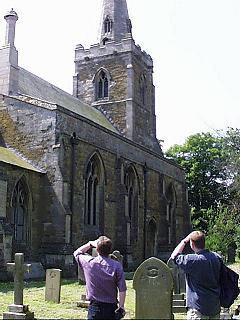
Still we did this fairly ordinary church the honour of a walk around (Neil and Alan here inspecting the spire) and noted the piece of Anglo-Saxon interlace work in the south wall of the chancel. But we gave up without getting in to see this highly unusual font and, as the pub in the village was just a drinking hole and we were rather hungry, we went back to the main Nottingham Road and to the village of Sedgebrook.
St Lawrence, SEDGEBROOK, Lincolnshire
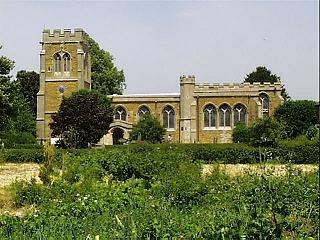
In the lovely sunshine it was disappointing to find that Sedgebrook church was also locked but there was keyholder information on a board, no phone numbers though just addresses and no map of where to find them! ChurchCrawlers do not give up that easily and Neil and I tracked down Abbey Close and walked towards no 9 only to spot a car zooming out of the driveway. Without any regard to my personal safety I flagged it down - and it was our keyholder. He reversed home, sending us back to the church, and passed the key to me as he drove by.
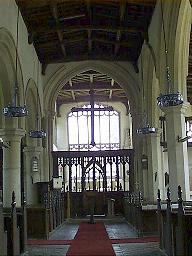
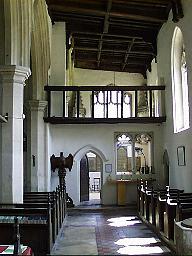
What a gem this church is, built c1468 when Sir John Markham was granted a licence for his chapel south of the chancel. The total absence of stained glass meant the church was flooded with light, much to Alan's disappointment as his specialist subject is medieval stained glass! The chancel and chapel have some exuberant decoration and fittings. Above (right) you can see that the chapel is screened off or more-walled off, a small doorway (with original door) and two-light window opening into the chapel beyond.
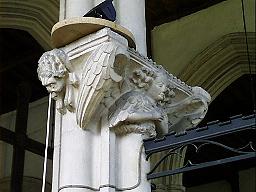
The arcade between chancel and chapel has an outsized angel bracket, and the end walls of both have large image niches, alas now empty. The picture below shows one of Neil's favourite points of the day, an incised slab to a Lady, Dorothy Markham who died in 1494 which surprisingly is one of the only monuments in the church.
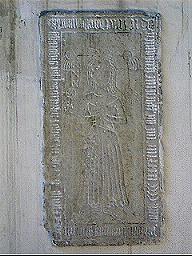
Pretty though Sedgefield was THE BAD NEWS was there was no pub here that we could find and it was now 1325. Studying Dr Digi's O.S.Map we found the next pub at Muston (Leicestershire) and drove straight there only to find it had burnt down the day before!! So ignoring this church we went on to Bottesford, and had a splendid late lunch and a long blether about churches, Pevsner, fellow members of ChurchCrawling not with us today (Simon, Les, Jo, Becky, The Captain amongst others!) and much much more! The very bad news for Alan was that the church at Muston DID have some medieval glass but I haven't had the heart to tell him this yet!
St Mary, BOTTESFORD, Leicestershire
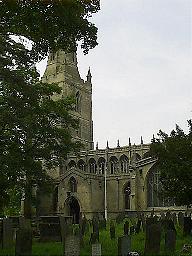
Eventually at 1520 we went to St Mary's (Neil and I walked from the pub, Dr Digi drove!!), a large church (Jenkins 3-stars). It stands in a sizeable churchyard in a loop of the River Devon but with many large trees making photographing the church outside rather difficult. The church has a soaring spire and the principle features of the church are Perpendicular, especially the fine clerestory with close set windows, two per bay.
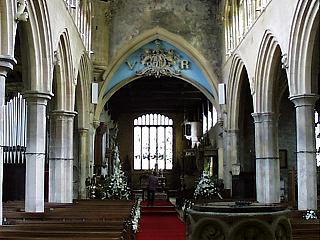
The interior is rather wide and stately, but marred by the odd tympanum over the chancel arch which carries the Royal Arms of Queen Victoria with its ugly letters. The spandrels of the arcade have some amusing beasts. However the architecture - fine though it is - is not the main reason for a visit to this church. The principle attraction is what is contained in the chancel which must make services at the high altar rather difficult.
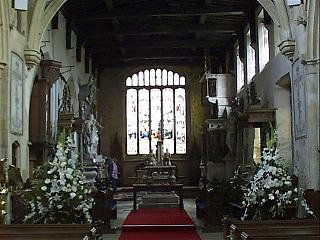
The chancel is filled by the huge collection of monuments to members of the Roos family rehoused here from Croxton Abbey after the Dissolution, and the series of the grandest monuments to the Earls of Rutland. From medieval effigies and brasses to exotic Elizabethan and Jacobean monuments, to the classical poses, this chancel has them all! 3stars?? We all agreed on an overall 4-star church, and if the spire alone gets Grantham five-stars then the monuments should have got Bottesford a five too. Some examples of this sculptural treasurehouse are illustrated below.
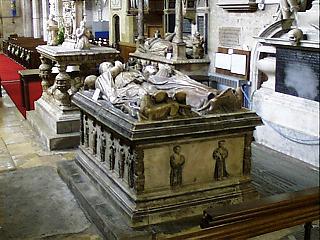
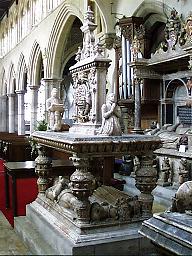
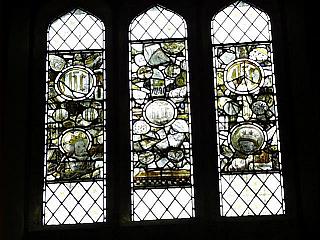
And high up in the south-west of the chancel is a three-light window nearly filled with fragments of medieval glass which made Alan happy and we all took pictures of it in celebration!
Time had ceased to have much meaning, we were still in need of another fix. So on into Nottinghamshire and Orston.
St Mary, ORSTON, Nottinghamshire
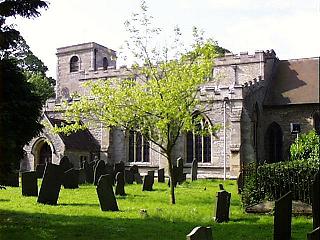
This is a typically ordinary English village church, no great architecture and a medley of architectural styles. The tower is of 1766, a classical stone structure of modest size which is rather cute. The aisle windows are a mixture of Decorated C14 and Victorian designs with exotic tracery. The battlements and clerestory seem Perpendicular. The chancel looks Early English but we felt it looked rather C19 work now.
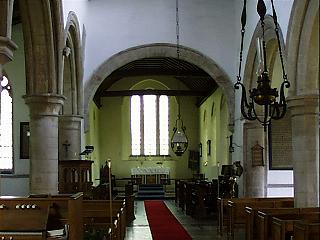
The interior shows some earlier work still, the north arcade is Transitional work of the late C12 but apart from a rather pretty font modestly "given by Mrs Constantia Kerchevall 1662" as the inscription on one face says, and a broken effigy of a Lady, not much else to see. So why did we come here?
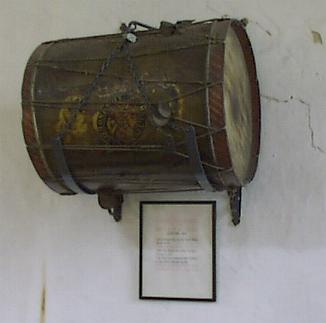
Well Dr Digi selected this church to see a drum on the wall of the north aisle from the Battle of Waterloo which we all shamelessly tried out! (Carefully of course!)
The day then had come to an end. Sadly Alan had trains to catch, and Neil and I a long drive home. We sadly took leave of each other just before 1800, but vowing to repeat this again next year. So will it be 16th June 2001? And if so, where?
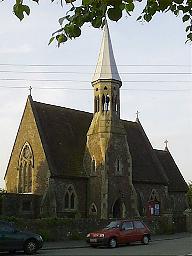
We got back to Falfield just as the sun was beginning to go down, and as you can see Neil's car was still there waiting! Whilst mine (Left) talked to his (right) I took a quick picture of this ordinary Victorian church (St George) with its rather unusual south porch-tower.